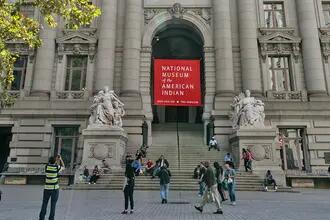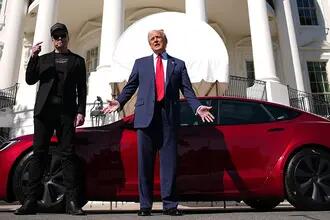
Since 2005, the United States may have gone overboard in its offshoring and outsourcing.
Donald Trump, angry Americans and misapplied trade theory
By: Farrokh Langdana
Americans are angry. One well-defined cause of their anger is the lack of jobs to replace the ones lost to global trade.
The "Ricardian" definition of Comparative Advantage – the DNA that powers global trade – may have been misapplied. Since 2005, the United States may have gone overboard in its offshoring and outsourcing. Much of what was sent overseas need not have been sent.
Many of the jobs that were lost in industries in which the U.S. supposedly had a Comparative Disadvantage, may actually have been sectors of Comparative Advantage, which needed to be not just kept at home but also increased for exports.
English economist David Ricardo’s concept of Comparative Advantage (CA) from the early 1800s powers all free trade models. It still works, it just needs to be used correctly.
A lightning explanation of Comparative Advantage
In this very simple example, we have 2 countries A and B, making two goods Xand Y, and they each have 100 units of labor, defined as L.
Let X = cutting-edge pharmaceuticals; Let Y = clothing (underwear, pajamas, bed sheets, etc., but this could be medium-skilled manufacturing, furniture, toys, etc.)
Let’s define ALX = 2, as in 2 workers needed to make 1 unit of Pharma in A. For example, BLY = 10, which is 10 workers needed for 1 unit of clothing in B, and so on.
Ricardo pointed out that even though A can make pharma and clothing with fewer workers than B, country A makes pharma more efficiently (with just 2 workers) while B takes 8 workers---four times as many. A also makes clothing with fewer workers than B can (5 compared to 10).
In other words, let’s say that you do IT strategy at work, for example, and you do this better than your assistant. But you can also put together the handouts for the big board meeting better than your assistant, too! So should you do it all? No. Let your assistant still make the handouts for the board meeting – your time is too valuable to be doing it all.
In other words, the opportunity cost incurred by you in preparing your handouts is too large. You need to just do IT strategy, since you do IT strategy more efficiently; according to Ricardian trade theory, you have a comparative advantage (CA) in IT strategy.
Algebraically, this translates to ALX/ALY < BLX/BLY. In this case, A would have a comparative advantage (CA) in making X, and therefore country B would have a CA in Y, with the inverse being true. In plain English, A would make Xmore efficiently (at less opportunity cost) than B.
In our example, we do indeed have ALX/ALY < BLX/BLY; 2/5 < 8/10; 0.4 < 0.8.
Ricardo then went on to prove that country A should specialize in making more pharma (Good X), and basically phase out (or de-emphasize) the making of clothing (good Y), and then trade with country B which has a CA in Y.
Country B makes Y (clothing) more efficiently and so country A imports Y from B and exports X (pharma) to B. Both countries would be able to consume more pharma and clothing by virtue of this specialization driven by how efficiently each makes X and Y – the differences in CA (0.4 compared to 0.8) drive the extent of specialization. The greater this difference, the more of Y(clothing/furniture/manufacturing) will be dropped by A and the more will Aemphasize the output in X.
So the workers in Pharma (good X) are happy---more jobs, more pay, they are exporting X to the world. But what happens to those who were in Y(clothing/furniture/appliances/manufacturing in general)?

Source of the anger
Trade theory would show that, maybe with a short lag, the workers in Y would transition to new jobs, and their kids would certainly not look for careers in the Ysector. Over time, the Y workers would transition to the X sector. But herein lies the problem – this transition has largely not happened in America. And the Ypeople are frustrated, bewildered, and angry.
So these free-trade-affected angry Americans are flocking to Donald Trump and also the Bernie Sanders camp! Here’s how we got here:
1. Ricardo’s free trade model was misapplied, and with tragic consequences. When our companies went on their monstrous offshoring and outsourcing spree of the mid-1990s, they were obsessed primarily with the lower labor costs there (in B).
They did not factor in other costs that would negate, or largely erode, the lower labor costs. Factors in country B such as infrastructure problems, corruption issues, intellectual property violation challenges, regulatory hurdles, huge worker turnover with each new batch of workers having to be re-trained, inconsistency in quality, rapidly rising wages in B, and expensive executives to be hired here at home to monitor the outsourcing challenges in B.
So, to adjust for these costs, let’s adjust BLX from 8 to 10, and BLY from 10 to 15, to include the extra costs of doing business in B. Now suddenly BLX/BLY = 0.67, and not 0.8 anymore. Remember, the differences in these ratios drive the amount of specialization.
2. Ricardian trade theory is all applied microeconomics. It completely missed the micro-macro interface. In other words, it missed the effects of the major macro recession such as the one that has hammered the U.S. since 2007, the greatest recession since the Great Depression.
Trade theory missed the effects of unfriendly business regulation here in the US that drove U.S. business overseas. It missed increased healthcare expenses thanks to Obamacare and also ignored the anti-business tax rates (one of the highest tax rates in the OECD) that make production of X in A so difficult. So with that, let’s increase ALX to 3, to incorporate the extra cost of doing business in A, due to, for example, more intrusive regulation, high corporate taxes, union pressure and a crumbling US infrastructure.
Now suddenly the ratios have become (ALX/ALY) = 3/5, and (BLX/BLY) = 10/15.
Interestingly, we see that the gradient in comparative advantages is 0.6 for A and 0.67 for B! In this case, by implementing “effective” CA, we see that the differences in CA are not nearly as pronounced (0.4 versus 0.8 earlier), and consequently, if we had incorporated all the real costs in our analysis, much less of Y would be offshored.
There would be fewer angry, frustrated, unemployed workers in many sub-sectors of the Y industry. Today, these former workers in the Y sector are the "salt of the earth" workers, many of whom are now flocking to Trump’s banner feeling betrayed by global trade, and are now fertile ground for the xenophobia that is rearing its ugly head.
EMBA alum, Al Porcello, described the misapplication of Trade Theory as, "The difference between physics and engineering. Physics problems always discuss an 'ideal' object on a frictionless surface... every engineer knows that no object is ideal and they cannot ignore friction. We’ve been ignoring friction for too long."
Associate Dean Joe Schaffer, former head of human resource at a Fortune 50 company and the current dean in charge of Rutgers Business School Executive Education Mini MBA programs and of the Asian International Executive MBA programs, brought this perspective: "Back then, outsourcing and off-shoring were totally driven by costs overseas — in fact, it was all driven by our bonuses, many of which were 100 percent of our salaries. Bonuses in the real world drive people to make some pretty bizarre strategic decisions. Short-term profitability tied to bonuses was all that mattered!”
3. Another factor driving this persistent unemployment is the housing crisis. With a large portion of homes "underwater" following the bursting of the housing bubble, job mobility became a casualty. Workers could not afford to sell their homes and move to a different part of the U.S. where jobs were available. U.S. labor mobility, long the envy of most mature economies, was severely hamstrung by the collapse in home prices.
4. Finally, this time around the “new” industries and technologies are not creating the number of jobs that accompanied past introductions of new technology. Facebook only has about 3,000 employees that handle over a billion clients. Twitter has even fewer. And the new technologies are, very controversially, not new technologies that are necessarily path-breaking. Do we really think that storing 50,000 songs and 3,000 movies on our watches (1,000 of these movies on the “silly things cute animals do”) will make the world a better place?
Red herrings in the news
Free trade deals like NAFTA and the TPP have been blamed for the current crisis. This is nonsense, red herrings, all of them.
Trade will happen irrespective of official free trade deals – stopping trade is like trying to stop water from flowing downhill. Trade is endogenous; it will happen. The sooner we realize that trade is driven by effective CA, the fewer sectors that will be mistakenly disrupted here at home, and the fewer lives we will disrupt.

And the fewer brands we will lose forever, and for no reason. For example, high quality US furniture lines should have stayed at home making high-end, quality furniture. Now, even affluent Chinese consumers are insisting on buying furniture made only in America for obvious reasons. And this domestic furniture is increasingly hard to find, as typically, sectors that are disrupted and offshored, hardly ever come back.
Right now all these disaffected workers in Industries Y are the “angry moths” flying to the Donald Trump banner.
An answer to Trump
We need to understand that some—some—of the angry moths flying toward the light of Trump are angry for legitimate reasons that pertain to misapplied free trade. But, I fear that the light to which they fly to, is not real. It is the false light of a false prophet.
To make the "angry moths" happy, we need to fix the “misapplied” Ricardian trade issue. We have to use Effective Comparative Advantage in decisions pertaining to outsourcing and offshoring, remove the macroeconomic impediments to trade here by unleashing supply side economics, by eliminating high taxes and excessive regulation. It’s time to fix crumbling infrastructure with a combination of limited and highly focused Keynesian spending on infrastructure and education.
And finally, we must remind the American public that nations, like individuals and like companies, show their real character when times are bad—in bear markets. We are in one now. The eyes of the world are on us. We must exhibit grace under pressure. This nation of immigrants can still show the world that it can again exercise global leadership and that “government of the people, by the people and for the people shall not perish from the earth.”
Farrokh Langdana is director of the Executive MBA Program and a professor of finance and economics.
© Farrokh Langdana. The author is grateful to his wife, Mary Langdana, Rutgers EMBAs extraordinaire, Al Porcello and Peter Murphy, and Associate Dean Joe Schaffer, for their editorial comments, feedback, and suggestions.
Farrokh Langdana and Peter Murphy, International Trade and Global Macropolicy, Springer Press, 2014.
David Ricardo, On the Principles of Political Economy and Taxation, 1821.
Russell Roberts, The Choice: A Fable of Free Trade and Protection, 3rdEdition, 2006.
Photo credit: Fogstock-AlinDragulin/Fogstock/Thinkstock
Press: For all media inquiries see our Media Kit


